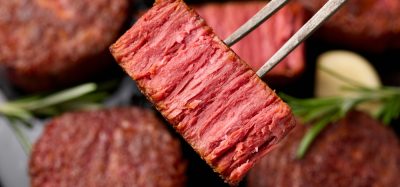SuperMeat reaches cost parity milestone in cultivated chicken production
- Like
- Digg
- Del
- Tumblr
- VKontakte
- Buffer
- Love This
- Odnoklassniki
- Meneame
- Blogger
- Amazon
- Yahoo Mail
- Gmail
- AOL
- Newsvine
- HackerNews
- Evernote
- MySpace
- Mail.ru
- Viadeo
- Line
- Comments
- Yummly
- SMS
- Viber
- Telegram
- Subscribe
- Skype
- Facebook Messenger
- Kakao
- LiveJournal
- Yammer
- Edgar
- Fintel
- Mix
- Instapaper
- Copy Link
Posted: 7 November 2024 | Ben Cornwell | No comments yet
The cultivated meat company can now produce cultivated chicken at $11.79 per pound, marking a milestone in sustainable, commercially viable lab-grown meat production.


The future of burgers? SuperMeat's grilled cultivated chicken patty.
Cultivated meat company SuperMeat has announced a major breakthrough, achieving cost parity for its lab-grown chicken with premium pasture-raised chicken in the US.
The company can now produce 100 percent cultivated chicken (85 percent muscle and 15 percent fat) at $11.79 per pound on a large scale, a significant step towards commercialisation. This achievement signals progress for the industry in its efforts to offer an affordable, sustainable alternative to conventional meat.
While many countries are moving closer to selling cultivated meat commercially, Singapore remains the sole country permitting the sale of cultivated meat to consumers.
The only product currently available in supermarkets is Good Meat’s chicken in Huber’s Butchery in the Southeast Asian country, which has a retail price equivalent to over $20 per pound. However, this product contains just three percent cultivated cells, combined with plant-based ingredients.
SuperMeat, recognised for its unique ability to grow chicken muscle and fat directly from animal cells, has refined its cell-culturing process to achieve unprecedented speed and efficiency. Using innovative cell lines and new animal-free feeding methods, the company reports it can now produce fat in just 24 hours and muscle tissue within four days. These accelerated production cycles have made it possible to reach high yields while keeping costs down.
Ido Savir, CEO and co-founder of SuperMeat, commented, “Current sentiment around cultivated meat includes scepticism regarding its scalability and market readiness, with concerns that cultivated meat may be more hype than a viable alternative. Our new report provides proof that with the right technology there is a commercially viable path to market.”
He added that SuperMeat sees a “tremendous opportunity for affordable cultivated chicken meat that supplies the same delicious taste and nutrition as premium chicken,” viewing this breakthrough as a route towards broad consumer acceptance and long-term adoption.
‘Creating a continuous production process with consistently high yields’
A key component of SuperMeat’s breakthrough is the development of a high-density cell culture that achieves 80 million cells per millilitre within nine days, without relying on genetic modification or animal-based ingredients. This density can be maintained over extended periods, creating a continuous production process with consistently high yields. The company has also significantly reduced feed costs, bringing them down to under $0.50 per litre by replacing costly animal-based components, like serum and albumin, with plant-based alternatives.
Further efficiencies stem from the company’s use of embryonic stem cells, which can rapidly grow to the size of mature muscle and fat cells. This method not only cuts production costs by almost 50 percent but also enables SuperMeat to deliver the texture, taste, and nutritional profile of real chicken.
The company’s production cycle begins with a nine-day cell growth phase, followed by a 45-day period during which meat mass is harvested daily from a compact 10-litre bioreactor. This continuous process yields around 66 pounds of cultivated chicken, equivalent to three pounds every two days, in contrast to the 42 days needed to rear a traditional chicken.
Looking to the future, SuperMeat projects that, when scaled to industrial levels, its process will produce 3 million kilograms (6.7 million pounds) of cultivated chicken per year – the equivalent of approximately 2.7 million traditionally raised chickens. This scale could reduce land use by 80 percent compared to conventional chicken farming.
By offering a transparent view of its technology, the cultivated chicken company hopes to build consumer confidence in cultivated meat. With an estimated 64 percent of US consumers unfamiliar with lab-grown meat, SuperMeat’s latest report aims to educate and engage, showcasing a pathway towards a more sustainable, animal-friendly food system.
Related topics
Cultured Meat, Product Development, Proteins & alternative proteins, Research & development, Sustainability, The consumer, World Food








